The United States continues to dominate global education in Electrical Engineering (EE), with seven of the world’s top 10 Electrical Engineering programs located at American institutions. The U.S. Bureau of Labor Statistics projects 9% employment growth for electrical engineers between 2024-2034, significantly faster than most occupations. This growth stems from emerging technologies in artificial intelligence, renewable energy systems, advanced semiconductor design, and next-generation wireless communications.
In this topic, we’ll discuss all the important aspects of Masters in Electrical Engineering in USA.
Key Highlights
| Apsect | Summary |
| Top Universities | MIT, Stanford, UC Berkeley, CMU, Georgia Tech |
| Popular Specializations | Power Systems, VLSI, Embedded Systems, AI & Machine Learning |
| Typical Duration | 1.5–2 years |
| Average Cost (Total) | $90,000 – $200,000 |
| ROI & Salaries | High; avg. salaries range $95,000 – $135,000 |
| Career Roles | Design Engineer, Systems Architect, RF Engineer, AI Hardware Engineer |
| Growth Outlook | 7%–9% (2024–2034), above average |
Top Reasons to Pursue Masters in Electrical Engineering in USA

Here are the Top Reasons to pursue Masters in Electrical Engineering in USA
1. Academic Excellence and Innovation
American universities account for 65% of all EE research citations globally (Nature Index 2025). Institutions like MIT, Stanford, and UC Berkeley consistently pioneer breakthroughs in:
- Quantum computing architectures
- Smart grid technologies
- Neuromorphic chip design
2. Unparalleled Industry Integration
The U.S. tech sector currently employs 1.7 million electrical engineers, with 142,000 new positions expected by 2026 (BLS 2025). Major industry partnerships exist with:
| University | Corporate Partners |
| Stanford University | Tesla, Google, Lockheed Martin |
| Georgia Tech | Delta Airlines, Southern Company, NCR |
| University of Texas | Samsung, Texas Instruments, Dell |
3. Financial Returns on Investment
Recent graduates report the following compensation packages:
| Specialization | Median Base Salary | Signing Bonus |
| Semiconductor Engineering | $128,500 | $35,000 |
| Power Systems | $112,000 | $28,000 |
| RF/Wireless Engineering | $118,000 | $32,000 |
Also Read: MBA in USA without work experience
Detailed Course Curriculum and Specializations
MS in Electrical Engineering typically spans 1.5 to 2 years. Programs generally require 30–36 credit hours.
Core Subjects:
- Advanced Circuit Theory
- Digital Signal Processing
- Electromagnetics
- Communication Systems
Electives & Specializations:
- Power Systems
- Wireless Communication
- Control Systems
- VLSI Design
- Embedded Systems
- Photonics
Thesis vs Non-Thesis Track
Master’s programs in electrical engineering typically require 30-36 credit hours and can be completed in 1.5-2 years of full-time study. Programs generally offer both thesis and non-thesis tracks:
- Thesis option: Typically includes 24-27 credits of coursework plus 6-9 credits of thesis research. This path is recommended for students considering doctoral studies or research-intensive careers.
- Non-thesis option: Usually requires 30-36 credits of coursework with a capstone project or comprehensive examination. This path is popular among students targeting industry positions.
| Criteria | Thesis Track | Non-Thesis Track |
| Research Requirement | High (mandatory) | Low/None |
| Career Path | Academia/Research | Industry-focused |
| Duration | Slightly longer | Faster (can finish in 1.5 years) |
| Final Requirement | Research paper + Thesis defense | Capstone project or final exam |
Also Read: MBA in USA without GMAT
Specializations in Masters in Electrical Engineering in USA
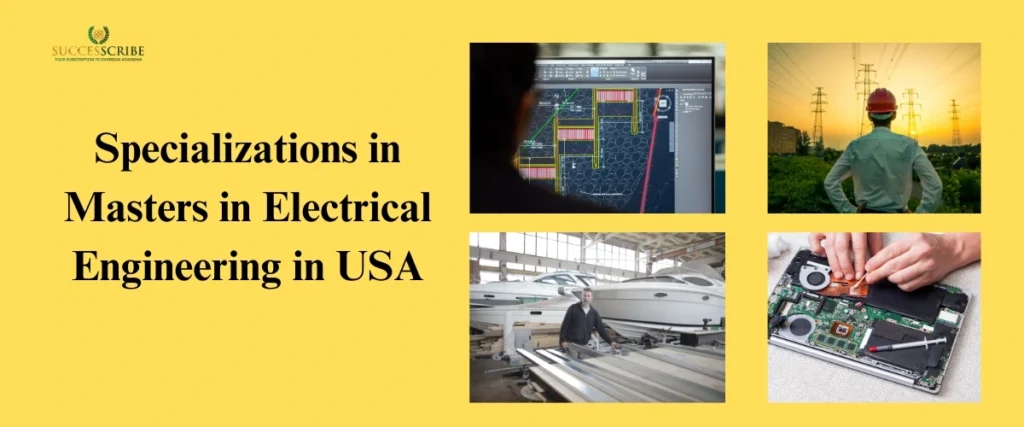
Electrical Engineering offers various specializations. Below is a table of popular focus areas:
| Specialization | Description | Career Prospects |
| Power Systems | Focuses on electric grids, renewable energy, and smart grids | Power engineer, Energy consultant |
| VLSI & Embedded Systems | Design of microchips and semiconductor devices | VLSI engineer, Hardware designer |
| Telecommunications | Covers 5G, wireless networks, and satellite communication | Network engineer, Telecom specialist |
| Control Systems | Automation, robotics, and industrial control systems | Control engineer, Automation specialist |
| Signal Processing | AI, image processing, and audio systems | Data scientist, DSP engineer |
| Machine Learning & AI | Integration of AI in electrical systems | AI engineer, Research scientist |
Best Specializations in Electrical Engineering (2025)
- Power Systems and Energy
- Microelectronics & VLSI Design
- Control Systems & Automation
- Embedded Systems
- Robotics and Mechatronics
- Wireless Communications & Signal Processing
- Computer Engineering
- Photonics and Optoelectronics
- Artificial Intelligence and Machine Learning (Interdisciplinary
- Quantum Engineering (Emerging in 2025)
Also Read: MBA in USA or UK
Eligibility and Admission Requirements
Here are the Requirements for Masters in Electrical Engineering in USA:
| Requirement | Details |
| Academic Qualification | 4-year Bachelor’s in EE or related field (minimum GPA: 3.0/4.0 or equivalent) |
| English Proficiency | IELTS (≥ 6.5) |
| GRE | Optional for many universities in 2025; still required by some top-tier programs |
| Statement of Purpose (SOP) | 500–1000 words explaining goals and reasons for pursuing MS in EE |
| Letters of Recommendation | 2–3 academic/professional LORs |
| Resume/CV | Including research, projects, internships, and work experience |
Standard Test Requirements
| Test | Minimum Score Needed (Avg) |
| GRE | 310–325 total (Quant ~160+) |
| IELTS | 6.5–7.5 |
| TOEFL iBT | 90–105 |
Admission Chances Based on Profile
| Profile Strength | GPA | GRE | Admission Chances |
| Strong | 3.7+ | 325+ | High (Top 10 Univ.) |
| Moderate | 3.3-3.6 | 310-320 | Mid-tier Univ. |
| Weak | Below 3.0 | Below 305 | Conditional/Prep Programs |
Top Universities/Colleges for MS in Electrical Engineering in USA
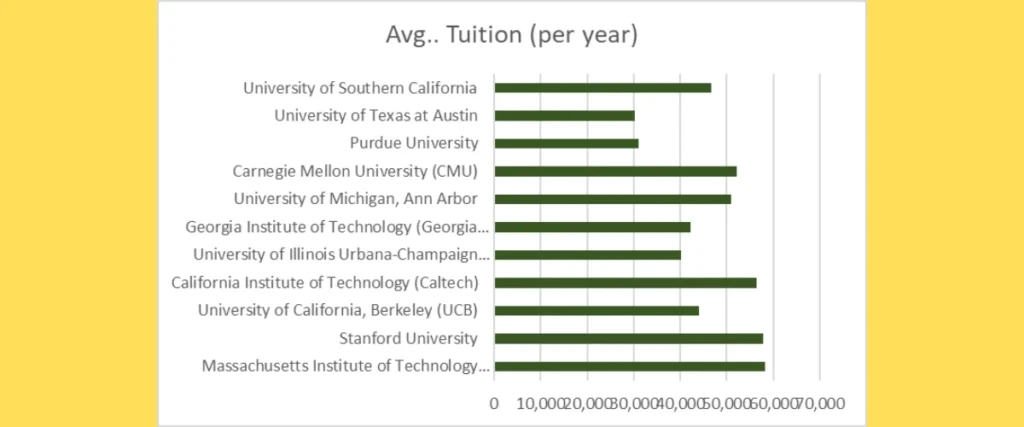
Here are the Top Universities for Masters in Electrical Engineering in USA, These universities are highly ranked, with competitive admissions and degrees from these universities are world-renowned.
| University | QS EE Ranking 2025 | Avg.. Tuition (per year) | GRE Required |
| Massachusetts Institute of Technology (MIT) | #1 | $58,240 | Optional |
| Stanford University | #2 | $57,861 | Optional |
| University of California, Berkeley (UCB) | #4 | $44,008 | Yes |
| California Institute of Technology (Caltech) | #7 | $56,364 | Optional |
| University of Illinois Urbana-Champaign (UIUC) | #18 | $40,162 | Optional |
| Georgia Institute of Technology (Georgia Tech) | #16 | $31,370 (in-state) / $42,230 (out-of-state) | Yes |
| University of Michigan, Ann Arbor | #12 | $50,872 | Optional |
| Carnegie Mellon University (CMU) | #14 | $52,100 | Optional |
| Purdue University | #23 | $31,104 | Yes |
| University of Texas at Austin | #58 | $30,200 | Optional |
| University of Southern California | #25 | $46,560 | Optional |
Also Read: MBA in business analytics in USA
The Top 5 Electrical Engineering Programs in the USA
Here are the Top 5 notable Electrical Engineering Programs in the USA:
- Massachusetts Institute of Technology (MIT)
- Key Strengths: #1 in both QS and ARWU rankings. Home to the Microsystems Technology Laboratories.
- Research Focus: Quantum computing, photonics, energy systems.
- Notable Fact: 92% of EE graduates secure jobs within 3 months.
- Stanford University
- Key Strengths: Silicon Valley location. Strong in AI hardware and VLSI.
- Industry Partnerships: Google, NVIDIA, Tesla recruit heavily.
- Admission Stats: 5% acceptance rate; average GRE Q: 168
- University of California, Berkeley
- Key Strengths: #1 public university. Leading in semiconductor research.
- Special Feature: Berkeley EECS department receives $85M annually in research funding.
- Carnegie Mellon University
- Key Strengths: Robotics and AI integration with EE.
- Unique Program: Joint MS in ECE and Machine Learning.
- Georgia Institute of Technology
- Value Proposition: Lowest tuition among top 5 ($29,000/year in-state).
- Co-op Program: 80% of students complete paid internships.
Admission Statistics for Top EE Programs
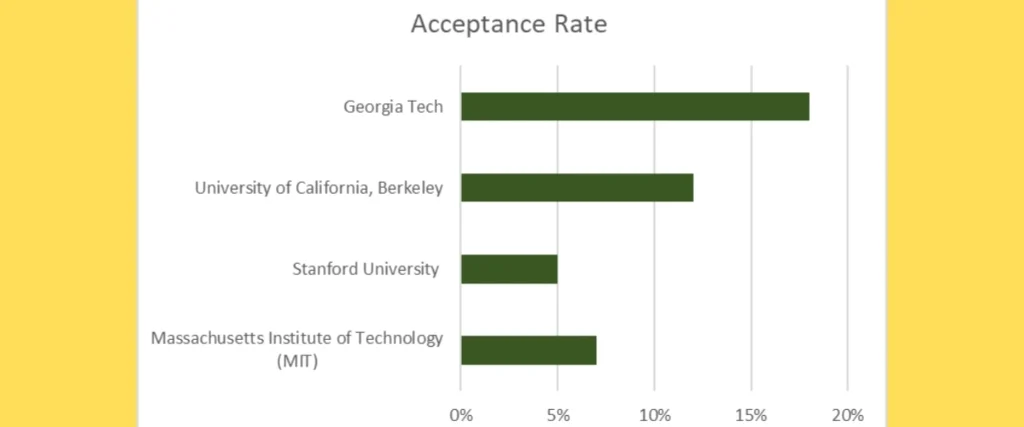
| University | Acceptance Rate | Avg. GPA | Avg. GRE |
| Massachusetts Institute of Technology (MIT) | 7% | 3.9 | 330 |
| Stanford University | 5% | 3.85 | 328 |
| University of California, Berkeley | 12% | 3.7 | 325 |
| Georgia Tech | 18% | 3.6 | 318 |
Cost of Studying MS in Electrical Engineering
Pursuing a Master’s degree in Electrical Engineering represents a significant financial investment. Tuition costs vary dramatically based on institution type, residency status, and program format:
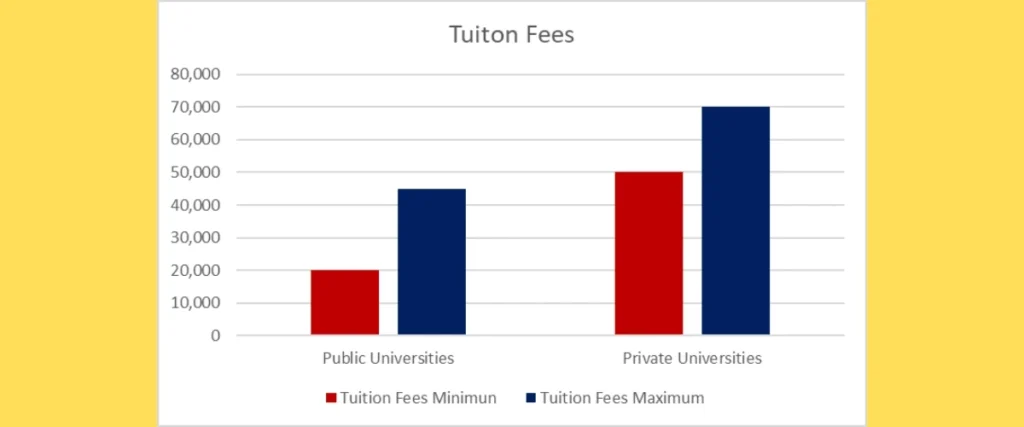
1. Tuition Fees
| Type of University | Tuition Fees (per year) |
| Public Universities | 20,000−45,000/year (Out-of-state) |
| Private Universities | 50,000−70,000/year |
2. Living Expenses
| City Tier | Housing | Food | Transport | Total Monthly |
| Tier 1 (NYC, SF) | 1,800−2,500 | 500−700 | 150−200 | 2,650−3,700 |
| Tier 2 (Austin, Atlanta) | 1,000−1,500 | 300−500 | 100−150 | 1,550−2,400 |
| Tier 3 (Raleigh, Tucson) | 700−1,200 | 250−400 | 80−120 | 1,130−1,920 |
3. Hidden Costs to Consider
Many students underestimate these additional expenses:
- Application Fees: 50−150 per university
- GRE/TOEFL Exams: 220+205 respectively
- Visa Fees: $510 (including SEVIS)
- Textbooks/Supplies: 1,000−1,500/year
- Travel Expenses: 1,500−3,000 (round-trip flights)
Total Pre-Arrival Costs: 3,000−5,000
4. Funding Options
| Funding Type | Coverage | Availability |
| Teaching Assistantship | Full tuition + $2,000/month | 25-40% of grad students |
| Research Assistantship | 50-100% tuition + stipend | 30-50% in research univ. |
| University Fellowships | 5,000−15,000/year | Competitive (5-10% get) |
| External Scholarships | 2,000−25,000 (one-time) | IEEE, ASEE, etc. |
5. Return on Investment (ROI) Analysis
Despite high costs, EE graduates see excellent returns:
| Scenario | Total Cost | Starting Salary | Breakeven Period |
| Public University | $90,000 | $105,000 | 1.5-2 years |
| Mid-Range Private | $140,000 | $115,000 | 2-2.5 years |
| Premium Private (MIT etc.) | $200,000 | $130,000+ | 2-3 years |
Even at top private universities, most EE graduates recover their education costs within 3 years due to high salaries in tech hubs.
Also Read: MBA colleges in USA
Career Opportunities & Salaries

The job market for electrical engineers with advanced degrees is robust, with a projected growth rate of 7% through 2030, according to the Bureau of Labor Statistics. This growth outpaces the average for all occupations (4%).
| Job Title | Average Annual Salary (USD) | Top Employers |
| Electrical Engineer | $88,000 – $110,000 | GE, Siemens, Honeywell |
| Power Systems Engineer | $95,000 – $120,000 | ABB, Schneider Electric, Tesla |
| VLSI Design Engineer | $110,000 – $140,000 | ARM, Cadence, Synopsys |
| Embedded Systems Engineer | $90,000 – $125,000 | Intel, Apple, Qualcomm |
| Design Verification Engineer | $100,000 – $125,000 | NVIDIA, AMD, Broadcom |
| Control Systems Engineer | $85,000 – $115,000 | Boeing, Rockwell Automation |
| RF Engineer | $100,000 – $130,000 | Raytheon, Lockheed Martin |
| Robotics Engineer | $95,000 – $135,000 | Boston Dynamics, Tesla |
Research Opportunities for MS EE Students
Masters in Electrical Engineering students in the USA can work in cutting-edge labs funded by:
- National Science Foundation (NSF)
- Defense Advanced Research Projects Agency (DARPA)
- Department of Energy (DoE)
- Private Sector Collaborations: With companies like Qualcomm, NVIDIA, Tesla, and Intel
Students can contribute to projects in:
- Quantum computing
- Neural interface systems
- Smart grid technology
- AI-integrated signal processing
Also Read: MBA in finance in USA
Masters in Electrical Engineering in USA Without GRE
Many top universities in the USA are moving towards holistic admission processes, and as of 2025, several institutions offer MS in Electrical Engineering without the GRE requirement, especially after the pandemic. This is a great opportunity for students who have strong academic backgrounds, research experience, or relevant work history but wish to avoid standardized testing.
Why Universities Waive GRE:
- Focus on overall profile: SOP, LORs, GPA, projects, and work experience
- Encouragement for diverse applicants
- Flexibility due to COVID-19 and evolving education policies
Top-Ranked Electrical Engineering Masters Programs Without GRE
Several highly regarded institutions now offer GRE-waived pathways for qualified applicants:
| University | Program | GRE Policy |
| University of California San Diego | MS in Electrical Engineering | Not Required |
| University of Florida | M.Eng in Electrical Engineering | Optional |
| University of Illinois Chicago | MS Electrical Engineering | Not Required |
| Northeastern University | MS Electrical & Computer Engineering | Waivable |
| University of Colorado Boulder | MS Electrical Engineering | Not Considered |
| Arizona State University | MSE Electrical Engineering | Optional |
| University of Massachusetts Amherst | MS Electrical Engineering | Not Required |
| University of Texas at Dallas | MS Electrical Engineering | Waived |
| Iowa State University | MEng Electrical Engineering | Not Required |
| San Jose State University | Not Required | |
| University of Kansas | MS Electrical Engineering | Not Mandatory |
| Oregon State University | MEng Electrical Engineering | Not Required |
Also Read: Masters in project management in USA
Top Hiring Sectors: Industry Trends and Employment Data
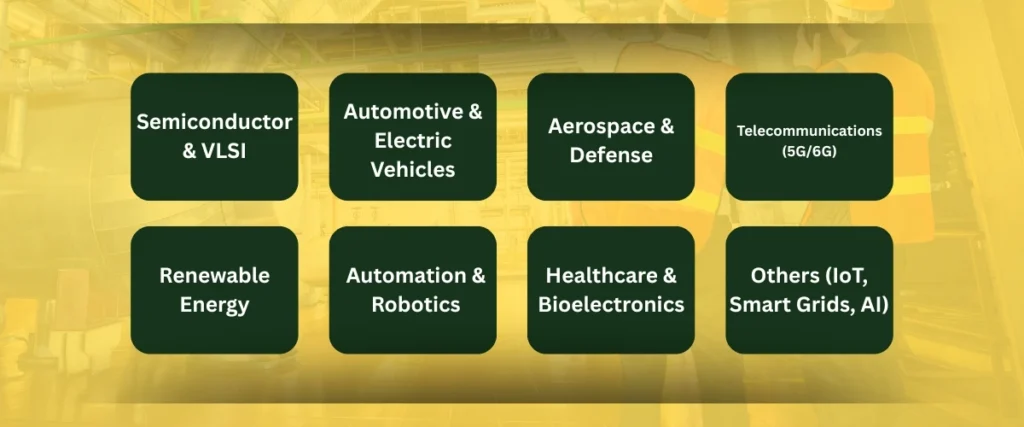
The demand for electrical engineers continues to rise in multiple sectors in 2025, driven by advancements in automation, renewable energy, and semiconductor technologies. Below is a breakdown of the top hiring sectors along with recent employment data:
| Sector | % Share of EE Job Postings | Average Salary (USD/year) | Key Employers |
| Semiconductor & VLSI | 28% | $105,000 – $130,000 | Intel, NVIDIA, AMD, Broadcom, TSMC |
| Automotive & Electric Vehicles | 18% | $95,000 – $120,000 | Tesla, Rivian, Ford, General Motors |
| Aerospace & Defense | 14% | $100,000 – $125,000 | Raytheon, Lockheed Martin, Northrop Grumman |
| Telecommunications (5G/6G) | 13% | $90,000 – $115,000 | Verizon, Ericsson, Qualcomm, AT&T |
| Renewable Energy | 10% | $88,000 – $110,000 | Siemens, ABB, NextEra Energy, Enphase Energy |
| Automation & Robotics | 9% | $95,000 – $120,000 | Boston Dynamics, Honeywell, Rockwell Automation |
| Healthcare & Bioelectronics | 5% | $85,000 – $110,000 | Medtronic, GE Healthcare, Philips |
| Others (IoT, Smart Grids, AI) | 3% | $90,000 – $115,000 | Schneider Electric, IBM, Amazon Web Services |
Visa and Immigration Considerations for International Students
International students comprise a significant portion of electrical engineering graduate students in the USA, necessitating an understanding of visa processes and post-graduation opportunities.
Most international students attend on F-1 visas, which permit full-time study at accredited institutions. The application process typically requires:
- Form I-20 from the admitting university
- Proof of financial resources covering at least the first year of study
- Evidence of English proficiency
- Demonstration of ties to home country
- Visa application fee
- SEVIS fee
OPT and H-1B Visa Opportunities After Masters in Electrical Engineering in USA
- OPT (Optional Practical Training) allows graduates to work for up to 3 years in the U.S. (STEM extension included).
- After OPT, most graduates switch to an H-1B visa sponsored by employers.
- H-1B Cap in 2025: 85,000 (65,000 general + 20,000 master’s cap)
- Top sponsoring companies: Google, Amazon, Intel, Apple, Microsoft
Conclusion
Pursuing a Masters in Electrical Engineering in USA represents an exceptional opportunity for academic and professional growth. With American universities dominating global EE research and education, students gain access to cutting-edge resources, world-renowned faculty, and unparalleled industry connections. The significant financial investment is justified by impressive ROI metrics, with most graduates recouping their expenses within 2-3 years thanks to competitive starting salaries across various specializations.
FAQs
Is GRE required for MS in Electrical Engineering in the USA in 2025?
Many top universities have made GRE optional, but some (like UC Berkeley, Georgia Tech) still require it. Check individual university requirements before applying.
What are the best specializations in Electrical Engineering for 2025?
Top specializations include:
1. Power Systems & Renewable Energy
2. VLSI & Semiconductor Design
3. AI & Machine Learning in EE
4. Wireless Communications & 5G/6G
5. Quantum Engineering (Emerging Field)
How much does an MS in Electrical Engineering cost in the USA?
Public Universities: 20,000–45,000/year (out-of-state)
Private Universities: 50,000–70,000/year
Living Expenses: 15,000–30,000/year (varies by city)
What are the job prospects after MS in Electrical Engineering?
Strong demand in:
1. Semiconductor & Chip Design (Intel, NVIDIA, AMD)
2. Electric Vehicles (Tesla, Rivian, Ford)
3. Telecommunications (Qualcomm, Ericsson, Verizon)
4. Renewable Energy (Siemens, NextEra Energy)
Which universities offer MS in EE without GRE?
Some top options:
1. University of California San Diego (UCSD)
2. Northeastern University
3. University of Texas at Dallas
4. Arizona State University (ASU)
Which universities offer the best value for money in EE programs?
Public universities generally offer better value, with Georgia Tech ($31,370 in-state/$42,230 out-of-state) and Purdue University ($31,104) standing out among top-ranked programs. Value considerations should include not just tuition costs but also assistantship availability, industry connections, and average starting salaries for graduates.
Related Post
Masters in automotive engineering in USA
Chemical engineering in USA
Aerospace engineering in USA
Engineering management courses in USA













